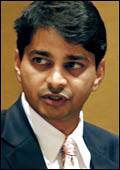 |
| BT-NASSCOM-GARTNER ROUNDTABLE: Panalists
(from left) Michele Caminos, Senior Analyst, Gartner, Ian Marriott,
Research Director, Gartner Research, Satoshi Yamanoi, Principal
Analyst, Gartner Dataquest (IT Services), Japan, Bobb Hayward,
Senior VP, Gartner (APAC), Sujoy Chohan, Country Director, Gartner
(India), Sunil Mehta, VP, Nasscom, Arun Seth, MD, British Telecom
India, Rita Terdiman, VP & Research Director, Gartner, and
Geoff Johnson, Research Director, Gartner Research at the summit
held in Mumbai on September 25-26 |
After
years of bruising growth, the IT industry in India has hit the brakes
hard. Last year, although revenues crossed the magical $10-billion
mark, there wasn't much jubilation in the industry. For one, the
downturn in the US has slowed it services growth to less than 30
per cent. The only silver lining is the robust growth in it-enabled
services, where revenues grew at an impressive 70 per cent last
year. Now, the Indian vendors-especially in it services-are searching
for new strategies and new markets. Some questions top of the mind:
How to increase the outsourcing business? How to move from plain
vanilla it services to business transformation consulting? And how
to open up markets in Europe and Japan? At the Nasscom-Gartner Summit
2002 held in Mumbai on September 25 and 26, BT brought together
a panel of experts to debate the issues. Seven of them were Gartner
analysts, including Sujoy Chohan, Group Vice President & Country
Director, Gartner (India); Bob Hayward, Senior Vice President, Gartner
(APAC); Rita Terdiman, Vice President and Research Director; Michele
Caminos, Senior Analyst; Satoshi Yamanoi, Principal Analyst for
Gartner Dataquest's it services in Japan; Ian Marriott, and Geoff
Johnson, Research Directors, Gartner Research. Nasscom was represented
by Vice President Sunil Mehta, and Arun Seth, MD of British Telecom
India & saarc. Excerpts from the discussion:
Business Today: Welcome,
ladies and gentlemen, to the BT-Nasscom-Gartner roundtable. Let
me kick off the discussion by asking Sunil what the industry's key
learnings have been in the last one year.
 |
 |
"Expertise
is what people are really looking for. One of the big challenges
for India is to move more towards BPO services away from traditional
software development services and project management"
Bob Hayward, Senior VP, Gartner
(APAC) |
"Faster, better,
cheaper and greater productivity are things that American customers
and companies understand. Certifications, they don't"
Rita Terdiman, VP, Gartner |
Sunil Mehta: Some new and some not-so-new
issues have been brought to focus. One is that the vendors need
to pay more attention to business continuity planning and security
practices. Two, margins have to be managed better because of the
growing bias towards fixed-price contracts. Then, all Indian vendors
are reconciling to the fact that the days of 25-30 per cent net
margins are gone. Almost all of them are focussing on strong volume
growth and are willing to sacrifice profits in order to ensure volume
growth.
Business Today: Bob, price is obviously
a big issue. But is that the only thing that customers are looking
for?
Bob Hayward: I don't think so. Expertise
is really what people are looking for. So one of the big challenges
for India is to move more towards BPO services away from traditional
software development services and project management services. It
sometimes worries me that people seem to think making this transition
is a done deal. It is a difficult transition to make, because you
are selling a different thing to a very different audience. Pricing
is definitely a concern, but process expertise is more important.
It's not readily obvious to me that any Indian company has that
today.
BT: Arun, do you agree with that assessment?
 |
 |
"We see the Asia-Pacific
IT services market growing from $28.4 billion in 2001 to $46.4
billion by 2005. China is the second fastest growing market,
but there are lots of opportunities for Indian vendors"
Michele Caminos, Senior Analyst,
Gartner |
"One of the key things
in BPO is matrix. If you can't define it in your client organisation
or supply organisation, then it's very difficult to manage your
relationships"
Sujoy Chohan, Country Director,
Gartner (India) |
Arun Seth: As far as Nasscom is concerned,
we are telling our members that price is only one aspect. The other
thing is quality. Look at the number of Indian vendors with quality
certifications...
BT: I can see Rita smiling, because
just this morning she was telling her audience how American companies
don't understand quality certifications like CMM Level 5.
Rita Terdiman: Quality and quality certifications
are immensely important because they allow Indian companies to do
their business better. But I don't think that they sell it as well
as they can to American customers. Faster, better, cheaper and greater
productivity are things American customers understand. Certifications,
they don't.
Sujoy Chohan: The success of some of
the BPO ventures spawned by MNC backoffices has got a lot of people
to believe that they can get into this business. That includes some
real estate companies. This has created a huge oversupply in the
industry and sooner or later that will hurt bottomlines.
BT: There's also the issue that Bob
raised, which is understanding your customer's business and processes,
of developing specific skills.
Rita: Well, one way they can do that
is by hiring Americans. Or hire Indians or anyone who has been there,
done that, people who-like I said today-walk the walk and talk the
talk. To me, that's the most important thing. Any industry or company
in any geography has its own culture, its vocabulary, and you just
have to know it. That's one reason why you need to hire people from
user organisations.
|
|
|
"You can't
have people coming here just for 5-6 years. You got to have
transition here. Otherwise, having an expat run the team will
add to your costs"
Arun Seth, MD, British Telecom
India |
"The natural
beachhead to Europe is the UK. If you look at Germany, Switzerland,
and Austria, you have 23 per cent of Europe. That's a good entry
point too"
Geoff Johnson, Research Director,
Gartner |
Arun: This is part of the transition
that Bob referred to earlier. You can't have people coming here
just for five or six years. You got to have transition here. Otherwise,
having an expat running the team will add to your costs.
BT: Rita, is the pricing flexible enough
to justify the cost of hiring, say, an American CEO or head of marketing?
Rita: You don't need a million of these
people. You need them in two ways: to do business development and
to strategise. As Bob said, skill transformation is important and
that is going to evolve over several years.
Sujoy: One of the key things in BPO
is matrix. If you can't define your matrix in your client organisation
or supply organisation, then it's very difficult to manage your
relationships. How many companies know what is the cost of making
one pay cheque or making one transaction or making accounting entries?
No one has looked into process costs. As the cost is broken down,
the Indian vendor can say, "Okay, that cost you two dollars,
we can do it in 50 cents." Suddenly, he has all the people
buying. So business matrix... process matrix is important. And that's
where work needs to be done.
BT: Rita, you speak of a global delivery
model. How radically different is that from what exists today?
 |
"Indian companies
that have MNC clients will need to be really selfish, really
aggressive and get their infrastructure and networks in place,
because the clients always assume the existence of such infrastructure"
Geoff Johnson, Research Director,
Gartner |
Rita: I would say it's radically different
in the sense that you have to help both the business people as well
as the IT people in various locations in the globe when it is required.
So you have technical and business capability out there, not in
every country by any stretch of imagination, but may be in each
of the three regions of the world to help with local language, local
customs, to be able to talk to the customer and to the customer's
customer. And also to capitalise on the niche skills of each country,
and provide back-up in case of global issues. I don't know whether
even an Accenture or EDs or IBM has a global model.
BT: Michelle made an interesting point
in her presentation about China being an opportunity and not a threat
for Indian vendors.
Michelle: That's right. We see the Asia-Pacific
it services market growing from $28.4 billion in 2001 to $46.4 billion
by 2005, and China will be a key driver of this growth. In 2001,
China accounted for 0.8 per cent of the world it services market,
and by 2005 it should go up to 1.2 per cent. China is the second
fastest growing market India, but there are lots of opportunities
for Indian vendors.
BT: But on the whole, Indian service
providers are still pretty much US-centric. They seem unable to
replicate their success in some other markets like Europe or Japan.
So, Ian, what are they doing wrong?
Ian Marriott: The position is different
because you are moving from having developed some very good business
in North America into another world with multiple languages and
cultures. But it is possible to penetrate the European markets,
and the natural beachhead is the UK. Some of the Indian vendors
are looking towards countries like Poland, Hungary and Czechoslovakia,
which are soon to join the EU. If you look at just Germany, Switzerland,
and Austria you have 23 per cent of Europe. That's a good entry
point.
BT: Yamanoi san, Japan has been eluding
Indian vendors as well...
|
|
|
"Japanese are
facing diffculty in HR and accounting BPO. They want to do it
internally, they want to do it through shared services. They
give it to their parent or group company and don't outsource
it "
Santosh Yamanoi, Analyst,
Gartner Dataquest (Japan) |
"All India
vendors are reconciling to the fact that the days of 25-30 per
cent net margins are gone. Almost all of them are focussing
on strong volumes"
Sunil Mehta, VP, Nasscom |
Satoshi Yamanoi: We are facing some difficulty
in hr and accounting BPO because Japanese users often think this
can get done through secretarial work. They want to do it internally,
they want to do it through shared services. They give it to their
parent or group company and don't outsource it.
Arun: I'll keep the company unnamed,
but it was a Japanese financial services company that wanted to
move its back-office to India about two years ago. The Okinawa government
gave a rate that was cheaper than India's. They subsidised the entire
labour cost, making it cheaper than India's.
BT: But obviously that's not sustainable...
Geoff Johnson: There's also the network
issue as far as India is concerned. Our view is that domestic Indian
companies that have MNC clients will need to be really selfish,
really aggressive and get their infrastructure and networks in place,
because clients always assume the existence of such infrastructure
and are often disappointed by the challenges of doing business with
India.
|
HOW TO TAP JAPAN
|
REDUCE "communication
gap"
ON-SITE JAPANESE or Japanese native
staffs needed
95% OF STAFF OF ACCENTURE, EDS at
Tokyo offices are Japanese
SELL "solution capability and
strong project management"
DON'T JUST SELL "labor cost
savings"
AT THE MOMENT, China IT firms are
getting strong in price competitiveness
BUILD ALLIANCE and partnership with
regional mega-players
HARD TO GO to users directly
PENETRATE "No Japanese communication
needed" area
EAI, embedded application, testing
& QA outsourcing etc. |
BT: Some companies like Infosys and Wipro
want to get into business transformation work. Is that workable?
Sunil: That depends entirely on the
business model a company wants to adopt. There's no one rule.
Bob: I don't think aspiring to be a
McKinsey is a very smart thing to do today. Indian companies need
to work harder on vertical speciality by industry, by sector, become
big in a smaller part than try to be all things to all people. If
they packaged up, encapsulated their expertise and stepped back
a little bit, and tried to be an Oracle or Microsoft or Siebel,
there could be great potential. I also think Indian companies should
diversify their skill-sets and invest in some emerging technologies
and in research... in quantum computing, in the intersection between
life sciences and it, and stake a claim globally for leadership
in a technology as well as in the implementation of that technology.
BT: Thank you all for participating.
|

